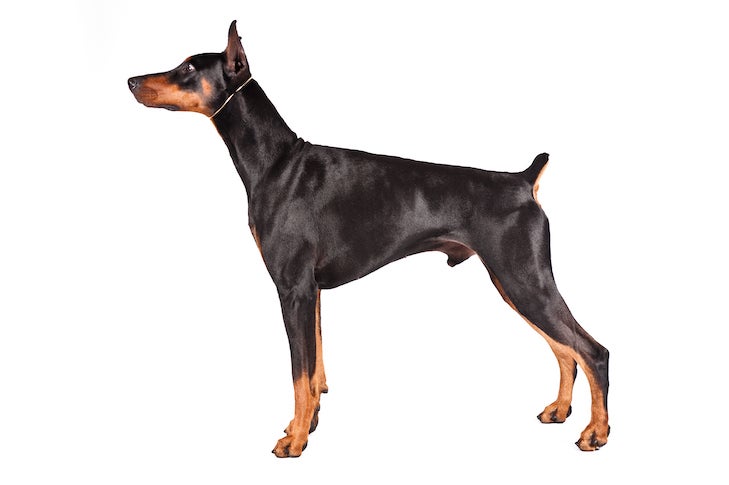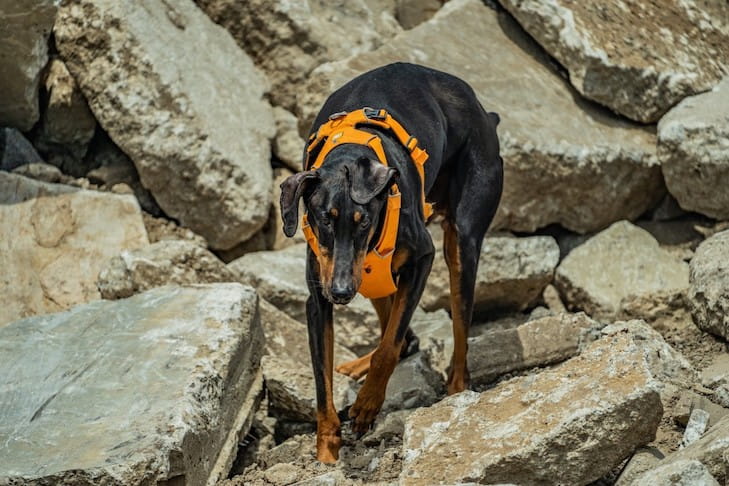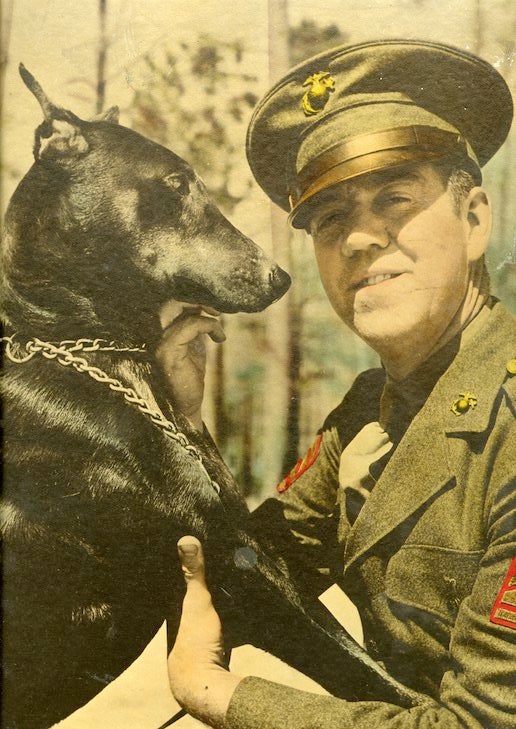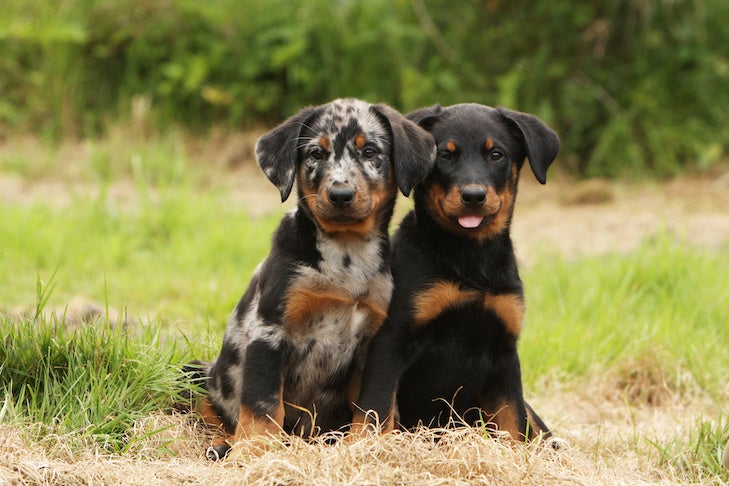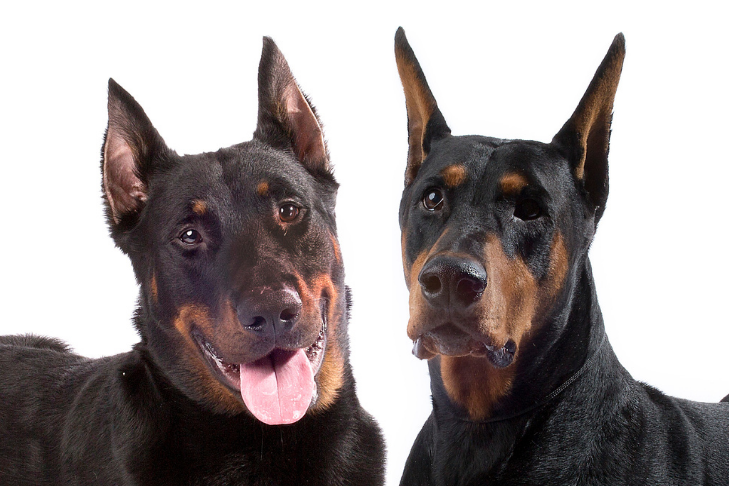
You are no doubt familiar with the Doberman Pinscher. After all, they are very popular. Dobermans are distinguished and powerful with a keen intellect, and you might think their size, strength, and markings make them one of a kind. But there is a like-sized, equally powerful, and similarly attractive breed you might mistake for the Doberman: the Beauceron. Don’t let the surface similarities fool you though. These two formidable breeds have different histories and purposes. Learn what makes each of them special and how to tell the difference.
One-Way Confusion
Leslie Hall of Pajant Dobermans is an AKC Breeder of Merit and the current corresponding secretary for the Doberman Pinscher Club of America. Although, in her many decades with the breed, she has never met anybody who mistook her Dobermans for Beaucerons, she notes the similarity between them in color, markings, and personality. “Each breed has rust markings appearing in the same place on their body. The heights are similar for both dogs and bitches. Many attributes described in the standards cover similar temperaments, expression, and relationship to the people in their circle – each being loyal, faithful, fearless, and intelligent. Energetic, with a noble carriage is attributed to both breeds.”
On the other hand, Victoria Paul, who has owned, trained, and competed with Beaucerons for 14 years, has encountered the Doberman/Beauceron confusion surprisingly often. Once someone even told her they didn’t know Dobermans came in “that color” after seeing her harlequin (merle), Luna.
Perhaps people assume Beaucerons are Dobermans but not the other way around because they have never heard of the less common Beauceron. Whatever the reason, Paul also believes the two breeds have much in common. “From what I know of the Doberman, I’d say both breeds tend to be very loyal and attached to their person. Both breeds are also known for being highly intelligent and versatile athletes, as well as protective of their home and people.”
- Beauceron
- Doberman Pinscher
Different Jobs
Because these two breeds have distinctly different jobs in their backgrounds, the Beauceron is a member of the Herding Group and the Doberman is part of the Working Group. According to Paul, the Beauceron’s herding role means they have traits typical of a sheepdog. “The Beauceron is incredibly slow to mature, often bores easily with repetitive training, and can be quite unforgiving of handler errors. Of course, in looks, the Beauceron has more coat, is a bit stockier, is never docked, and should have the firmly attached double-dewclaws on the rear feet.”
Hall agrees the biggest difference between the breeds is their separate purpose. She explains that although the Beauceron is used in military and police work, they are primarily a herding dog. Whereas the Doberman is primarily meant to work with people. “The Doberman is the only AKC breed bred as a protector of humans, rather than animals, and is a new breed compared to the history of the Beauceron.”
- Beauceron
Distinct Histories
How much older is the Beauceron? Well, most likely hundreds of years older. According to Paul, “Although still uncommon in most countries outside of France, the breed is very old and was first documented in the 1500s. The Beauceron historically was developed as an all-purpose farm dog and used for both working the flock and guarding the home.”
Thanks to the area where they were first developed, the plains region surrounding Paris known as La Beauce, this breed is also known as Berger de Beauce which translates to shepherd of the Beauce. Based on their markings, the breed has yet another name, Bas Rouge, which translates to red stockings. Although it’s hard to tell on looks alone, the Beauceron is closely related to the Briard.
In contrast, the Doberman is a relatively new breed and the first one was registered with the AKC in 1908. However, they were developed in Apolda, Germany by Herr Louis Dobermann who worked as a tax collector, night watchman, and dog catcher in the middle to late 1890s. Hall says, “He wanted a brave and fearless dog that would protect him as he made his rounds. The exact “recipe” will never be known; however, historians of the Dobermann believe the Rottweiler, the old German Shepherd (now extinct), German Pinscher, and Weimaraner are the main ingredients. It is documented that crosses to the English Greyhound and Manchester Terrier were incorporated into the mixture to improve the appearance of the Doberman Pinscher.”
- Beauceron
- Doberman Pinscher
Devoted to Their People
Paul sums up the Beauceron’s personality with one word: devoted. These dogs love their people and want to be with them all the time. They are also notoriously slow to mature, both physically and mentally, so owners must set boundaries and start training from an early age. These affectionate dogs are also boisterous and physical. Because of their active nature and keen intelligence, they require lots of mental and physical stimulation. Otherwise, they will create their own often destructive activities to occupy their time.
Paul also warns that although Beaucerons are comedians at heart, you have to watch what you reinforce. “The breed is also known to have a sense of humor, and you learn to never laugh at a Beauceron’s antics, unless you want to encourage that behavior! Also, be prepared for hair. Lots of hair everywhere. They shed a lot!”
According to Hall, Dobermans are also focused on their people, in fact their family is the center of their universe and they will protect them. These loyal and watchful dogs are always alert and aware of their surroundings, keeping one eye open at all times. They are also determined independent thinkers which Hall admits is code for sometimes stubborn. Yet Dobermans are also obedient, as long as they have a stable, firm, and consistent leader to follow. And these fun and funny dogs love to be occupied, so give them a job to do, lots of exercise, and challenges for their quick mind.
- Beauceron puppies
- Doberman Pinscher puppies
Hall describes the breed as sweet yet protective, stubborn yet biddable, beautiful, powerful, elegant, and athletic. And all those qualities make them what she calls the do-it-all Doberman. “Willing to do what you want them to. A generalization, but so often the case. You want to hike? Okay. You want to do barn hunt? Cool. Lure coursing? Awesome. Dock diving? Sure (except for those that do not like to get wet, some Dobermans believe they melt when wet). Agility? Let’s go. Now! Obedience? Let’s get to class! Scent and nose work? What are we searching for today? And more!”
Next time you encounter a dog that sort of resembles a Doberman, don’t be so sure. You might be meeting a Beauceron. Hopefully, now you’re better able to tell them apart. But based on their amazing personalities, you’ll be lucky either way.



